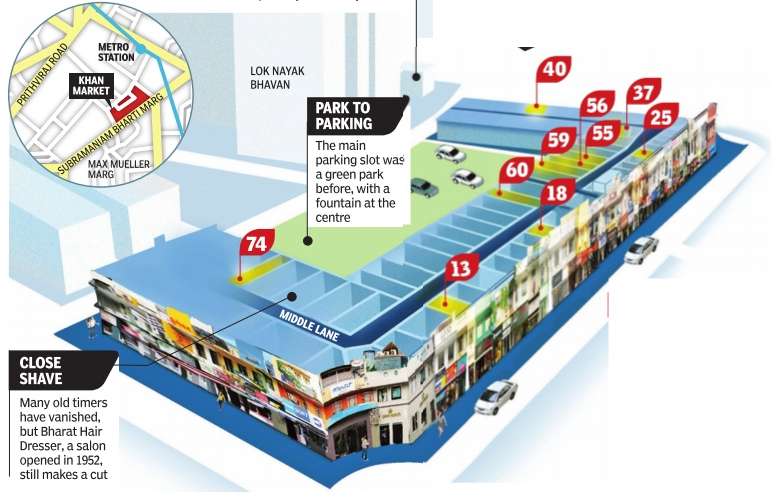Delhi: Khan Market
This is a collection of articles archived for the excellence of their content. |
Contents |
History

The Times of India, Jun 28 201
Ambika Pandit
The city's swishest market was once a cozy neighbourhood with a central park and chaupal. The market was named after freedom fighter Khan Adul Jabbar Khan ( brother of Khan Abdul Ghaffar Khan) and the rent even then, joke the residents, was exorbitant -Rs 50. The first buyers got 75-square yard flats for a stiff price -Rs 9,500. Flat No 13 of Khan Market belongs to one of the 74 families that moved here in the 1950s. Today, only 10 families continue to live here with memories of a very different Khan Market, a neighbourhood that once reflected the aspirations of post-Independence India.
Café Turtle, Full Circle
2000-2020
Cafes are not just about coffee spoons. As the iconic Café Turtle and Full Circle, the book store that housed it, in Khan Market shut, there is a sense that an era has ended.
A cultural oasis in the middle of one of the most expensive retail destinations in the world, Café Turtle was a pit stop for writers, journalists, artists, book lovers, travellers and more, all enchanted by the sense of unhurried homeliness it served alongside its much loved cakes.
When it opened in December 2000, Delhi was still new to the café culture. Spaces for the young or arty were few. Khan Market itself was a shadow of its present self.
Publishers Poonam and Shekhar Malhotra, owners of the historic Hind Pocket Books, who started their imprint Full Circle for “new age” books in 1998, found this sleepy market as the perfect home for their book store with Café Turtle within it, on the lines of European neighbourhood cafes.
The first home was a spacious plot facing a beautiful silk cotton tree — where La Opera now stands. “Profit was not our motive. We just wanted a nice expansive space where people could be themselves,” says Poonam.
People could sit, browse, stare, chat, eat a slice of home-made cake. “The day we opened, friends like Arun Kapur (director of Vasant Valley school) and Dr Ashwani Chopra (of Aashlok Hospital) came over and served as waiters,” remembers Poonam. All cakes were made in the publisher’s home — lemon, carrot, orange, banana and walnut, and a gooey chocolate cake. There were fresh salads and juices. A few months down the line, two college kids waiting to get into catering schools abroad were roped in to cook in their own homes. One of them, Manu Chandra would go on to helm Olive Bangalore. All through the changing times, even in the midst of the fiercely competitive world of restaurant retail, Café Turtle remained a thing rare to find in India: a restaurant that is about a community, and grew into a Delhi landmark even as it shifted to the middle lane in 2009.
Commercial value



The apporoximate monthly rent for a 450-sq ft shop is around Rs 7-8 lakh. The estimated sale price of a flat here is around Rs 16 crore but sales are uncommon so the estimates mean little.
Given the commercial frenzy surrounding the market it might be hard to believe that it once had a central park with a fountain or that one of the parking lots used to be a chaupal.
The neighbourhood that was the soul of Khan Market started disintegrating in the late 1980s when residents started selling or renting out their flats to relocate to bigger houses elsewhere in the city .
Entry to the 10 flats where Khan Market's original families still live is through the middle lane which is now packed with cafes, restaurants (at least 36 of the 74 flats here house restaurants) and boutiques. The houses are, in fact, hard to find because of the bright signboards that dominate the building façade.
For the families living here, keeping the market out of their homes is hard work.